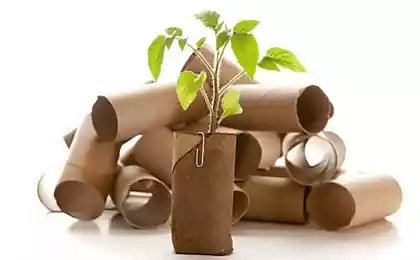504
Drip irrigation in the greenhouse with their hands
The water temperature ofMost vegetable crops are experiencing stress and slow growth due to low temperature of irrigation water. Especially the negative effect that cold water has to heat, may lead to the death of plants.

Since water with drip irrigation has been slow in coming and have time to go through a rather long maze of thin tubes, it is well heated before you get in the soil. It makes possible not only the connection, drip irrigation system directly to the water, but even the use of water from the well or wells.

Of course, in the latter case, the main role is played by the length of the line and the working pressure in the system. Therefore it is necessary to first perform the system test, the outlet temperature should not be below 18 °C. If the water is warm enough, from installing full-size tank can save the buffer capacity of 100-150 litres. To raise the capacity of 2-2. 4 meters above the ground — that is the main problem in greenhouses, most of which are quite squat.
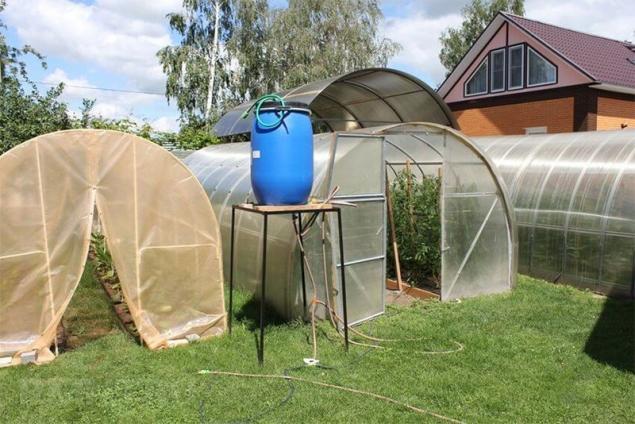
The task is also solved by the installation of very cheap and low-power flow heater. Otherwise, you need to attend to outdoor installation of the tank and increase its efficiency as a lining a heat insulator, painting in black color and maybe install CAN. Soil aerationis Another important advantage of drip irrigation — it does not soak the soil to a state of liquid mud, so the roots have a chance to breathe, and they need not less aboveground parts of the plant.
So the effect was expressed more clearly, it should be a special way to prepare the soil. The top layer, which is planting seeds, mixed with absorbent vermiculite or cereal husks. Wrigley stirring should be done after thorough drying of the earth.

However, even if such training ground should not organize continuous feed "drops". The soil should from time to time to dry, so best would be turning on the system 2-3 times a day at certain times, for which the system can be equipped with automatic regulating and shut-off valves.
If watering is carried out only once a day or less to maintain optimum soil moisture will help mulching. Or rather, laying on top of drippers or tape layer sluggish grass, hay or straw in the 7-10 cm thick.
Comfortable laying roadsIn the greenhouse, there is one condition, promoting more rapid and technologically advanced breeding main pipes. We are talking about the roof: at the height of couple of meters above the ground mounted to the frame, so why not use it to secure the pipes? In this case, the system would not have to completely disassemble every year for digging soil, and the layout of the frame allows you to accurately align the pipe. Laying under the roof also contributes to a more intensive warming up of water.

At the exit from the tank the pipe is lowered at 40-60 cm for more convenient installation of piping and manifold, then rises again to the horizon, which is below the bottom of the tank by 10-15 cm For laying of trunk routing is well suited pipe HDPE, it can tolerate seasonal temperature fluctuations and ultraviolet.
When laying it is recommended to focus on the track for the passage and positioning the pipes directly above them. Under the roof of the connection pipe runs regular press fittings, installation is possible even alone and from the ladder.
The bends of the highway down the tubes of smaller cross-section at the beginning of each patch, shut-off valve is mounted at a height of outstretched arms. At ground level the pipe moves in a horizontal manifold through tee or knee. The edges of the pipes to drown out the wooden plugs in the walls of the drilled holes and install flush valves for tapes.
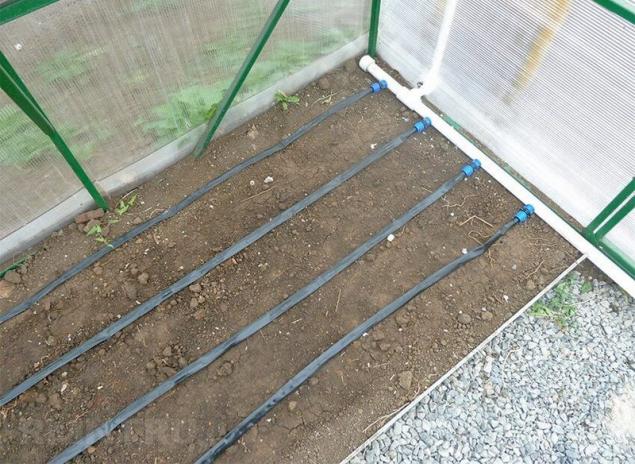
If irrigation is used, a dropper, a main pipe of large cross section extends across the beds, bends her down to the ground and through the knee pass into the lower trunk thin tube along the entire bed or each row heading. Through the crosspieces and tees to this channel emitter connected.
Strips or dropperIf you are familiar with the variety of systems of drip irrigation, the question type selection is not necessary as such — it all depends on the crops grown, size of greenhouse and the characteristics of the wiring system.
If the greenhouse is oriented on a year-round cultivation of vegetable crops, often in preference to the larger and taller varieties with a landing distance of 1 meter. The dropper in this case is ideal because the tape is so large step is difficult to find.
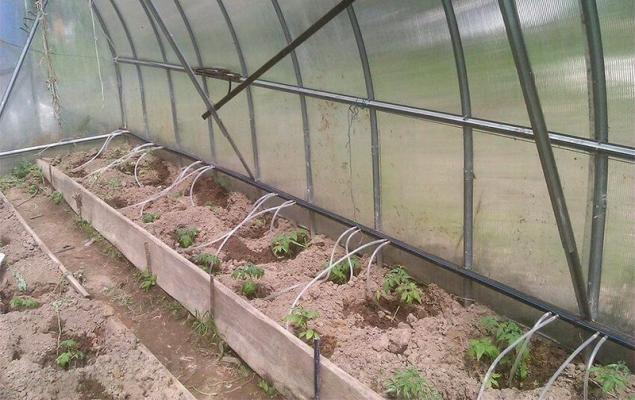
Especially pronounced is the use of drippers when watering the tree of histoplamosis tomatoes and cucumbers. In the ripening period of the fruit these plants consume water significantly more than at the stage of planting. Tape such a bandwidth does not have the same dropper can be set adjustable, or you can change them as they grow, plants.
For greenhouses-nurseries and cultivation of Bush plants of the ribbon will suit best. They have optimal IVS and is able to evenly humidify a large area. A well known disadvantage of strips is that their capacity need to be manually adjusted, while it is strictly calibrated droppers. Therefore, when using drip tape is recommended instead of ball valves to install the valve.

Hydraulic pipingThere are two recommended Mac: from storage tanks and for direct connection.
At the outlet of the tank is installed ball valve and strainer. If you plan on fertilizing through irrigation water — once the crane is set to block automatic fertigation. This same functionality is achieved by mixing a concentrate directly into the tank, but not all chemicals are harmless to its walls.
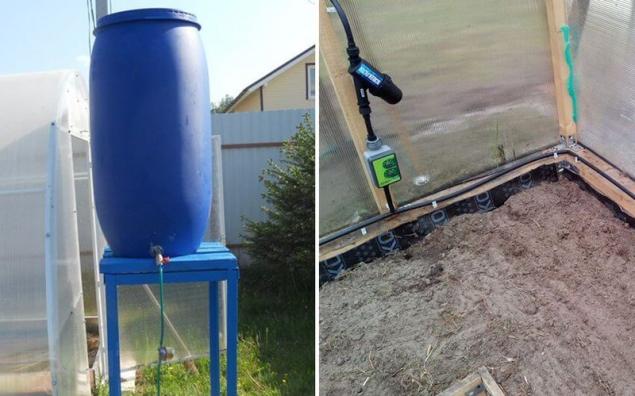
Over dosing fertilizers installs the cartridge filter to 50 microns, which should hold undissolved fertilizer and small particles capable of settling in the dripper. After mounted manifold with ball valves and threaded connections on the outlets, from which pipes are getting a divorce further down the greenhouse. Protection against air suction and non-return valve when the upper wiring is not required, the rail acts as a water seal. However, the bends of the highway to complete the check valves still needed.
Modes of operation and maintenanceBefore planting the plants, the system is tested on the leveled ground. The intensity of irrigation is regulated by the valves visually for the size of the wetted areas, so that when the system is turned on each bed received the right amount of water.
With buffer tank and great to work with. Its volume is known, which means you can accurately control the amount of water adjusted to the throughput of each line. Volume of 150-200 litres will be enough for the average daily irrigation of the greenhouse.

In greenhouses with an area of more than 1 Ara the same tank can provide all the plants with watering, but with automatic control. In such cases, the volume of the tank is consumed for irrigation of individual sections, the switch performs a controlled shut-off valves on the manifold. published
P. S. And remember, only by changing their consumption — together we change the world! ©
Join us in Facebook , Vkontakte, Odnoklassniki
Source: www.rmnt.ru/story/garden/1119084.htm

Since water with drip irrigation has been slow in coming and have time to go through a rather long maze of thin tubes, it is well heated before you get in the soil. It makes possible not only the connection, drip irrigation system directly to the water, but even the use of water from the well or wells.

Of course, in the latter case, the main role is played by the length of the line and the working pressure in the system. Therefore it is necessary to first perform the system test, the outlet temperature should not be below 18 °C. If the water is warm enough, from installing full-size tank can save the buffer capacity of 100-150 litres. To raise the capacity of 2-2. 4 meters above the ground — that is the main problem in greenhouses, most of which are quite squat.

The task is also solved by the installation of very cheap and low-power flow heater. Otherwise, you need to attend to outdoor installation of the tank and increase its efficiency as a lining a heat insulator, painting in black color and maybe install CAN. Soil aerationis Another important advantage of drip irrigation — it does not soak the soil to a state of liquid mud, so the roots have a chance to breathe, and they need not less aboveground parts of the plant.
So the effect was expressed more clearly, it should be a special way to prepare the soil. The top layer, which is planting seeds, mixed with absorbent vermiculite or cereal husks. Wrigley stirring should be done after thorough drying of the earth.

However, even if such training ground should not organize continuous feed "drops". The soil should from time to time to dry, so best would be turning on the system 2-3 times a day at certain times, for which the system can be equipped with automatic regulating and shut-off valves.
If watering is carried out only once a day or less to maintain optimum soil moisture will help mulching. Or rather, laying on top of drippers or tape layer sluggish grass, hay or straw in the 7-10 cm thick.
Comfortable laying roadsIn the greenhouse, there is one condition, promoting more rapid and technologically advanced breeding main pipes. We are talking about the roof: at the height of couple of meters above the ground mounted to the frame, so why not use it to secure the pipes? In this case, the system would not have to completely disassemble every year for digging soil, and the layout of the frame allows you to accurately align the pipe. Laying under the roof also contributes to a more intensive warming up of water.

At the exit from the tank the pipe is lowered at 40-60 cm for more convenient installation of piping and manifold, then rises again to the horizon, which is below the bottom of the tank by 10-15 cm For laying of trunk routing is well suited pipe HDPE, it can tolerate seasonal temperature fluctuations and ultraviolet.
When laying it is recommended to focus on the track for the passage and positioning the pipes directly above them. Under the roof of the connection pipe runs regular press fittings, installation is possible even alone and from the ladder.
The bends of the highway down the tubes of smaller cross-section at the beginning of each patch, shut-off valve is mounted at a height of outstretched arms. At ground level the pipe moves in a horizontal manifold through tee or knee. The edges of the pipes to drown out the wooden plugs in the walls of the drilled holes and install flush valves for tapes.

If irrigation is used, a dropper, a main pipe of large cross section extends across the beds, bends her down to the ground and through the knee pass into the lower trunk thin tube along the entire bed or each row heading. Through the crosspieces and tees to this channel emitter connected.
Strips or dropperIf you are familiar with the variety of systems of drip irrigation, the question type selection is not necessary as such — it all depends on the crops grown, size of greenhouse and the characteristics of the wiring system.
If the greenhouse is oriented on a year-round cultivation of vegetable crops, often in preference to the larger and taller varieties with a landing distance of 1 meter. The dropper in this case is ideal because the tape is so large step is difficult to find.

Especially pronounced is the use of drippers when watering the tree of histoplamosis tomatoes and cucumbers. In the ripening period of the fruit these plants consume water significantly more than at the stage of planting. Tape such a bandwidth does not have the same dropper can be set adjustable, or you can change them as they grow, plants.
For greenhouses-nurseries and cultivation of Bush plants of the ribbon will suit best. They have optimal IVS and is able to evenly humidify a large area. A well known disadvantage of strips is that their capacity need to be manually adjusted, while it is strictly calibrated droppers. Therefore, when using drip tape is recommended instead of ball valves to install the valve.

Hydraulic pipingThere are two recommended Mac: from storage tanks and for direct connection.
At the outlet of the tank is installed ball valve and strainer. If you plan on fertilizing through irrigation water — once the crane is set to block automatic fertigation. This same functionality is achieved by mixing a concentrate directly into the tank, but not all chemicals are harmless to its walls.

Over dosing fertilizers installs the cartridge filter to 50 microns, which should hold undissolved fertilizer and small particles capable of settling in the dripper. After mounted manifold with ball valves and threaded connections on the outlets, from which pipes are getting a divorce further down the greenhouse. Protection against air suction and non-return valve when the upper wiring is not required, the rail acts as a water seal. However, the bends of the highway to complete the check valves still needed.
Modes of operation and maintenanceBefore planting the plants, the system is tested on the leveled ground. The intensity of irrigation is regulated by the valves visually for the size of the wetted areas, so that when the system is turned on each bed received the right amount of water.
With buffer tank and great to work with. Its volume is known, which means you can accurately control the amount of water adjusted to the throughput of each line. Volume of 150-200 litres will be enough for the average daily irrigation of the greenhouse.

In greenhouses with an area of more than 1 Ara the same tank can provide all the plants with watering, but with automatic control. In such cases, the volume of the tank is consumed for irrigation of individual sections, the switch performs a controlled shut-off valves on the manifold. published
P. S. And remember, only by changing their consumption — together we change the world! ©
Join us in Facebook , Vkontakte, Odnoklassniki
Source: www.rmnt.ru/story/garden/1119084.htm
The plumbing at the dacha with his hands: the simplest ways device
Blondes were on average smarter than other women





